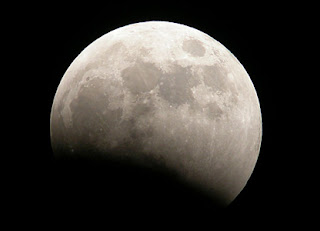A lunar eclipse occurs when the Moon passes behind the Earth so that the Earth blocks the Sun's rays from striking the Moon. This can occur only when the Sun, Earth, and Moon are aligned exactly, or very closely so, with the Earth in the middle. Hence, a lunar eclipse can only occur the night of a full moon. The type and length of an eclipse depend upon the Moon's location relative to its orbital nodes. The most recent total lunar eclipse occurred on December 10, 2011. The previous total lunar eclipse occurred on June 15, 2011; The recent eclipse was visible from all of Asia and*Australia, seen as rising over Europe and setting over Northwest North America. The last to previous total lunar eclipse occurred on December 21, 2010, at 08:17 UTC.
Unlike a solar eclipse, which can only be viewed from a certain relatively small area of the world, a lunar eclipse may be viewed from anywhere on the night side of the Earth. A lunar eclipse lasts for a few hours, whereas a total solar eclipse lasts for only a few minutes at any given place, due to the smaller size of the moon's shadow. Also unlike solar eclipses, lunar eclipses are safe to view without any eye protection or special precautions, as they are no brighter (indeed dimmer) than the full moon itself.

















No comments:
Post a Comment